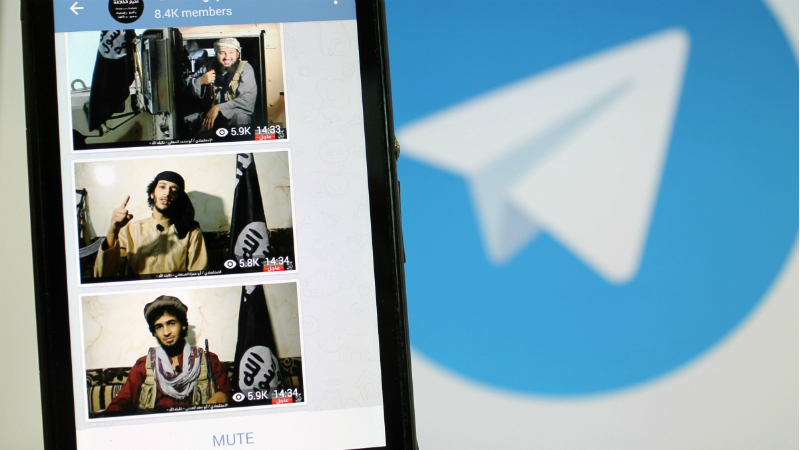Virtual Caliphate Rebooted: The Islamic State’s Evolving Online Strategy
Editor’s Note: The Islamic State’s territorial expansion and burgeoning online presence seemed to rise together. As the group lost territory, however, its online presence evolved. Jade Parker and Charlie Winter, two leading analysts of the Islamic State’s propaganda machine, describe how the group’s propaganda production has changed in the post-Caliphate era and how we can prepare for the next round.
***

Published by The Lawfare Institute
in Cooperation With

Editor’s Note: The Islamic State’s territorial expansion and burgeoning online presence seemed to rise together. As the group lost territory, however, its online presence evolved. Jade Parker and Charlie Winter, two leading analysts of the Islamic State’s propaganda machine, describe how the group’s propaganda production has changed in the post-Caliphate era and how we can prepare for the next round.
***
The territorial Islamic State has collapsed, its once-contiguous caliphate fragmenting into an archipelago of inter-connected statelets in rural parts of Iraq and Syria. The organization will undoubtedly live on but, in order to do so, it will have to metamorphose into something else, swapping its overt governance programs for covert insurgent tactics and terrorism, whenever and wherever the conditions allow.
Reflecting this change in tactical emphasis, its media priorities have been changing, too, as indicated by the gradual winding down of its official propaganda activities over the last two years. Today, the majority of its provincial media offices lie dormant, their overall productivity dropping by about 90 percent compared with the summer of 2015, when it was at its height. This is not just a media decline—it is a full-fledged collapse, driven by both external factors like territorial loss and degraded manpower, and internal decision-making on the part of the organisation itself.
In the absence of the torrent of propaganda that once characterized it, the virtual caliphate—the operations of which comprise much more than media production and dissemination—has also been evolving. As its offline manifestation has buckled and distorted, its online presence has come to look much more like that of a “conventional” terrorist group—a shift that, while it certainly validates the progress made against the organization in Iraq and Syria in recent years, raises a far subtler, more insidious range of issues that will likely prove to be more difficult for policymakers to meaningfully address.
This is because, in contrast to bygone years, which saw the brunt of the Islamic State’s online activities being borne on the shoulders of official operatives, the lion’s share of this new effort appears to have been left to the organization’s increasingly important legion of online supporters-cum-volunteer media operatives, which it refers to as the munasirun. While many of them have been around for years, they have come into their own as orators of the caliphate brand in recent months.
As a result, the distinction between official and unofficial material and operations has begun to blur, a development that means we need to revisit previous attempts to map the caliphate’s online ecosystem. It is helpful to consider these diffuse efforts as four overlapping subsystems: official media amplification, unofficial media production, ideological incubation, and logistics and facilitation. While aspects of these categories may appear to be new, each of these spheres of activity is the product of gradual evolution, not revolutionary innovation.
With respect to the first prong, amplification, munasir networks are more important than they have ever been. Indeed, without them, the media arm of the Islamic State would have been silenced long ago. Consider the likes of the Nashir News Agency and Nasikh, both of which act as amplifiers for the handful of official propaganda channels that remain online. By replicating content from these sources—which are now, due to the raft of counterterrorism interventions made by tech companies in recent years, almost impenetrable to outsiders—nodes like these insulate the official network while at the same time ensuring that interested observers can still access the few official media products that continue to emerge on a daily basis.
Besides the day-to-day amplifiers, there are also those that focus on archiving historical content. Some provide a bespoke request-only service—it is literally a case of saying “Give me the Raqqah Province video that lasted thirty-six minutes,” and waiting—while others just try to dump everything online in quick succession with the goal of creating one mammoth clearinghouse containing everything. The Upload Knights, which has been around for years now and is one of the most prominent of this ilk, offers something akin to a greatest hits album for the Islamic State’s “golden years.”
Formerly, when the organization’s media houses were still able to flood the online space with new material, these archivist-amplifiers were not so important. Today, however, in light of the near silence of official media outlets, their significance is growing.
With respect to the second sphere of activity—that is, unofficial media production—the munasir network has recently up-scaled its operations. In previous years, most munasir nodes were confined to the kind of amplification efforts described above. In response to the declining capabilities of the official propagandists, they are creating more content than ever, their wares running the gamut from videography to miscellaneous commentary and translation, with varying degrees of success.
Expanding on the efforts of the likes of Turjuman al-Asawirti, whose flashy polemics are still being produced to this day, the online space is increasingly saturated with content produced by those that were once considered to be the peanut gallery of the Islamic State jihad. For the most part, these materials—which tend to focus on deriding secularism, railing against moderate Islam, and attacking ideological enemies of the caliphate—seem to be borne of munasir intuition rather than organizational design, though there is evidence to suggest the content is monitored and regulated by officials in the Islamic State's media apparatus.
Related to the above is a third, more nebulous, aspect of the virtual caliphate: ideological incubation. This manifests in social media and messaging platforms, on which members swap views about everything related to the Islamic State. At the end of 2017, trending topics included anything from its theological volte face on religious excommunication to the Taliban’s “willful” apostasy in Afghanistan. The most recurrent theme by far, though, was the idea that the Islamic State will remain no matter what; these discussions positioned the caliphate’s recent territorial losses as trials that, far from indicating that the group was down and out, actually verified that it was on the “Right Path.”
Besides this, in an attempt to broaden its audience while avoiding anti-terrorism countermeasures, supporters of the Islamic State have also tried to surreptitiously mainstream certain aspects of its ideology. One example of this is the invite-only mentoring circles and social media group pages for which normal indicators of Islamic State involvement are entirely obscured. These virtual seminaries operate at the scholarly end of the jihadist spectrum, disseminating religious texts and encouraging discussion and understanding, while also offering an opportunity for intensive peer-to-peer mentoring in the Islamic State’s creed.
They—both the virtual seminaries and the encrypted group discussions—seem to be attempting to insulate the caliphate idea from intellectual attacks and preserve its ideological integrity. Some comments might focus on undergirding the social principles of the dawlawi (read “Islamic State-y”) identity, while others put forth a series of theological arguments against the Islamic credentials of rival scholars and groups like al-Qaeda and Hay’at Tahrir ash-Sham (formerly Jabhat al-Nusra). Often, these groups and the materials they propagate are not terroristic at all. This, along with the deliberate omission of references to ideological affiliation, enables the sites’ administrators to state that they are simply proselytizing Islam, an age-old tactic of extremist cheerleading that has proven to be nigh on impossible to challenge through legislation.
The final subsystem of activity—logistics and facilitation—primarily relates to attack planning, administrative functions, and resource allocation. Islamic State terrorist attacks can usefully be broken down into three types: directed operations, abetted operations, and inspired operations. In the context of the first, munasir networks play little to no role; directed individuals deliberately minimise their online footprint in order to maximise their operational security. However, when it comes to operations that are abetted or inspired by the Islamic State, their input is more prominent. Indeed, networked elements of the community have been known to provide personalized logistical support.
In addition to the individualized approach, there are also munasir-run channels that offer constant streams of tactical guidance for independently-motivated actors. The content ranges from bomb and poison recipes to theological advice and back issues of Dabiq, Rumiyah, and the al-Qaeda magazine, Inspire. Through distributors such as these, which appear to operate with official sanction—and, at times, direction—from the Islamic State, the virtual caliphate is seemingly being used to plug the logistical gap left by the absence of its official publications.
The Islamic State also uses online structures and mechanisms for on-the-ground logistics and administrative activities. This digital infrastructure facilitates financing and material support and provides a formal intra-organizational communication network that connects geographically disparate Islamic State-affiliates, allowing them to coordinate official media operations, recruitment, and other tasks central to the bureaucratic functions of the offline side of the organization. The resource allocation and logistics-focused facets of the virtual caliphate are central to supporting the Islamic State’s longer-term objectives; because of its importance to the organization, there can be little doubt that they remain active today.
In this post-Mosul, post-Raqqa, post-Mayadin phase, the Islamic State seems to have taken its foot off the official media pedal to instead put more effort into the logistics side of its insurgent equation. This change in virtual tack has been on the horizon for well over a year now. It is part of a shift in strategic direction prefigured by the organization's changing emphasis on hijrah, the act of traveling to the caliphate to join the Islamic State. Though hijrah is still encouraged and facilitated to some extent in other theaters outside of Iraq and Syria, the Islamic State no longer prioritizes this form of recruitment the way it did in the past. Instead, it has been supplanted by a new, more immediately troubling, shorter-term objective: retributive terrorism.
This is not a new addition to the Islamic State’s asymmetric repertoire, but the urgency with which it is now being encouraged and facilitated is. Before its territorial decline, a successful terrorist operation was a tactical bonus. Now, it is a strategic necessity, both defensively in Iraq and Syria, as well as offensively in other geographic regions. The online sphere has been tailored to facilitate these attacks more efficiently than ever before.
This situation did not appear out of nowhere. As Haroro Ingram and Craig Whiteside have noted, the Islamic State’s online activities were always a virtual means to a real-world end. With the fall of its urban redoubts in the Middle East, that real-world end changed. The virtual caliphate has evolved to keep up with its shifting goals, building on the years its operatives spent entrenching its administrative and logistical capabilities online. While the Islamic State’s overall appeal may be a shadow of what it was in 2015, its ability to inspire and stage attacks and cultivate fledgling clusters of ideologically-aligned militants around the world could well exceed our expectations in months and years to come.






